Table of Contents
- Introduction
- Editor’s Choice
- Frequency of Concussion in Sports Statistics
- Adolescents Reporting Concussions
- Sports Concussion in Students Statistics
- Demographic Insights
- Rugby Sports Concussion Statistics
- Soccer Sports Concussion Statistics
- Public Opinion on Concussion Suffered in Sports and Long-Term Brain Damage Effects Statistics
- Post-Sports Concussion Syndrome Statistics
- Impact on Viewership
- Remedies and Policies for Treating Concussion in Sports Statistics
- Initiatives to Counter Sports Concussion Statistics
- Regulations for Sports Concussion Treatments Statistics
- Technological Developments in Sports Concussion Treatments Statistics
- Recent Developments
- Conclusion
- FAQs
Introduction
Sports Concussion Statistics: A concussion is a mild traumatic brain injury caused by a sudden impact or jolt to the head or body, resulting in temporary brain function disruption.
Common in contact sports like football and hockey, concussions manifest through symptoms such as headache, dizziness, and confusion.
Diagnosis is primarily clinical, using tools like the Sports Concussion Assessment Tool (SCAT). At the same time, neuroimaging helps rule out severe injuries.
Management involves rest and a gradual return to activity, guided by symptom resolution. Prevention includes protective equipment, rule modifications, and education on proper techniques.
Repeated concussions pose long-term risks, including potential cognitive decline and chronic traumatic encephalopathy (CTE). Underscoring the importance of effective management and preventive measures.
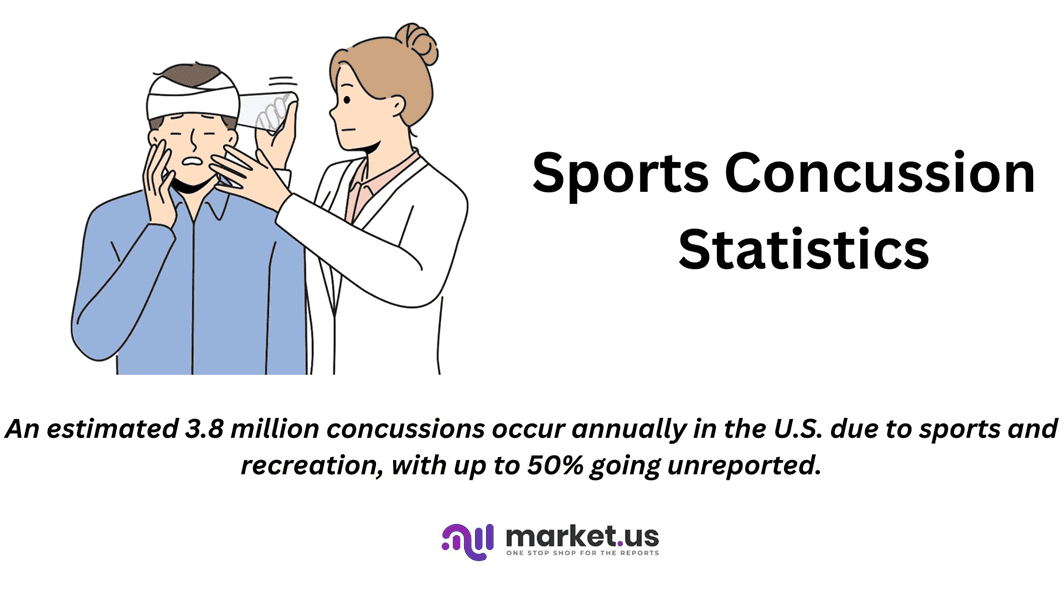
Editor’s Choice
- In October 2022, a survey was conducted to gauge public opinion in the United States on how common concussions are in various sports. The results revealed that boxing and American football were perceived as the sports most associated with concussions. 61% and 60% of respondents, respectively, believe concussions to be “very common” in these sports.
- A survey of Canadians reporting concussions while playing sports revealed varying responses across different age groups. Among those aged 18-34, 42% reported having experienced a concussion, while 58% did not.
- As of 2017, data on U.S. students in grades 9-12 revealed differences in the incidence of concussions from playing sports based on gender. A higher percentage of male students reported experiencing concussions. With 10.2% indicating they had one concussion compared to 8% of females.
- Between 2013 and 2015, the average number of reported concussions in the NFL varied significantly by team. The Cincinnati Bengals had the highest average, with 17 reported concussions.
- A 2014 survey explored public opinion on various aspects of concussion prevention and the potential for long-term brain damage in sports. 60% believed that players who suffer a head injury should be required to take a minimum set amount of time off to recover.
- A survey conducted in Canada revealed strong public support for several policies aimed at managing and preventing concussions in youth sports. A significant majority, 95%, supported requiring coaches to be educated on the risks of concussions as a condition of their eligibility to coach. With only 5% opposing this policy.
- Recent international guidelines, such as those emerging from the 2023 Amsterdam International Consensus on Concussion in Sport. It has been pivotal in updating protocols and tools to aid in the recognition and management of concussions.
Frequency of Concussion in Sports Statistics
- In October 2022, a survey was conducted to gauge public opinion in the United States on how common concussions are in various sports.
- The results revealed that boxing and American football were perceived as the sports most associated with concussions, with 61% and 60% of respondents, respectively. Believing concussions to be “very common” in these sports.
- Ice hockey and rugby also had significant percentages, with 38% and 35% of respondents, respectively, considering concussions “very common” in these sports.
- Soccer was viewed differently, with 39% stating concussions were “somewhat common,” while 21% believed they were “very common.”
- Lesser-known sports like lacrosse and gymnastics had fewer respondents considering concussions “very common,” at 16% and 14%, respectively.
- However, a notable proportion of respondents were uncertain about these sports, with 31% for lacrosse and 20% for gymnastics, selecting “not sure.”
- In baseball or softball, 34% thought concussions were “not very common,” and 34% had the same opinion for basketball, though 30% and 31%, respectively, still considered them “somewhat common.”
- Volleyball and tennis were seen as the sports with the least risk, with only 11% and 8% believing concussions were “very common,” while 36% for volleyball and 35% for tennis felt they were “not very common.”
- A significant proportion of respondents for tennis (25%) and volleyball (12%) believed concussions were “not common at all,” further emphasizing the perception of these sports as lower-risk activities.
- Additionally, uncertainty was quite prevalent, with a range of 12% to 31% of respondents selecting “not sure” across the sports surveyed.
(Source: Statista)
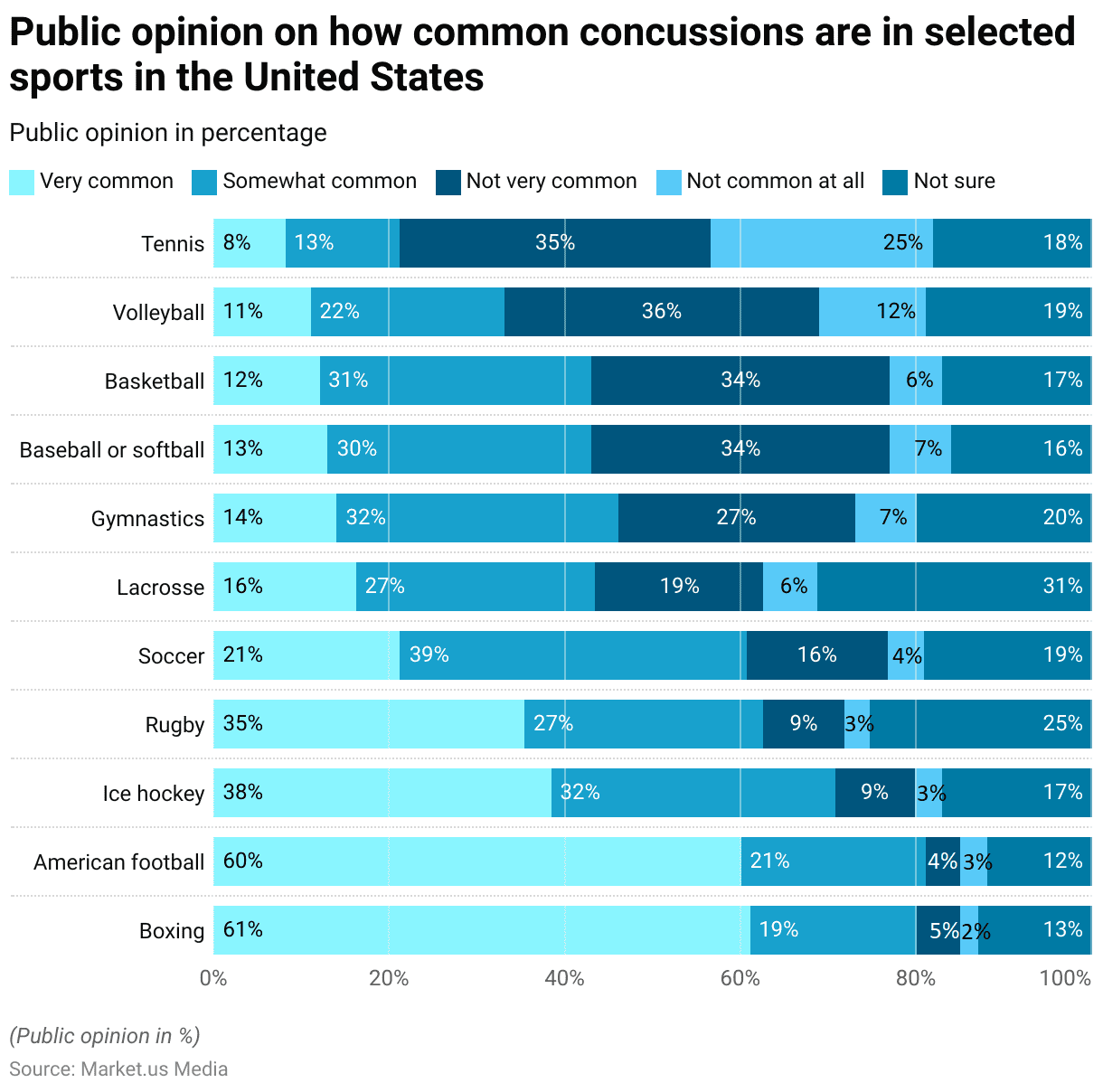
Adolescents Reporting Concussions
- From 2016 to 2020, the percentage of U.S. adolescents who self-reported experiencing concussions showed an overall increasing trend.
- In 2016, 19.5% of adolescents reported having any concussion, with 14% reporting one concussion and 5.5% reporting two or more concussions.
- The percentage slightly decreased in 2017, with 18.2% reporting any concussion, 13.3% reporting one concussion, and 4.9% reporting two or more concussions.
- However, by 2018, the percentage of adolescents reporting concussions returned to the 2016 levels. With 19.5% reporting any concussion, 13.6% reporting one concussion, and 5.9% reporting two or more concussions.
- The trend continued upward in 2019 when 21.6% of adolescents reported having any concussion. With 14.9% reporting one concussion and 6.7% reporting two or more concussions.
- The highest percentages were observed in 2020, with 24.6% of adolescents reporting any concussion, 17.7% reporting one concussion, and 6.8% reporting two or more concussions.
- This data indicates a notable increase in the self-reported incidence of concussions among U.S. adolescents over the five years.
(Source: Statista)
Take advantage of our unbeatable offer - buy now!

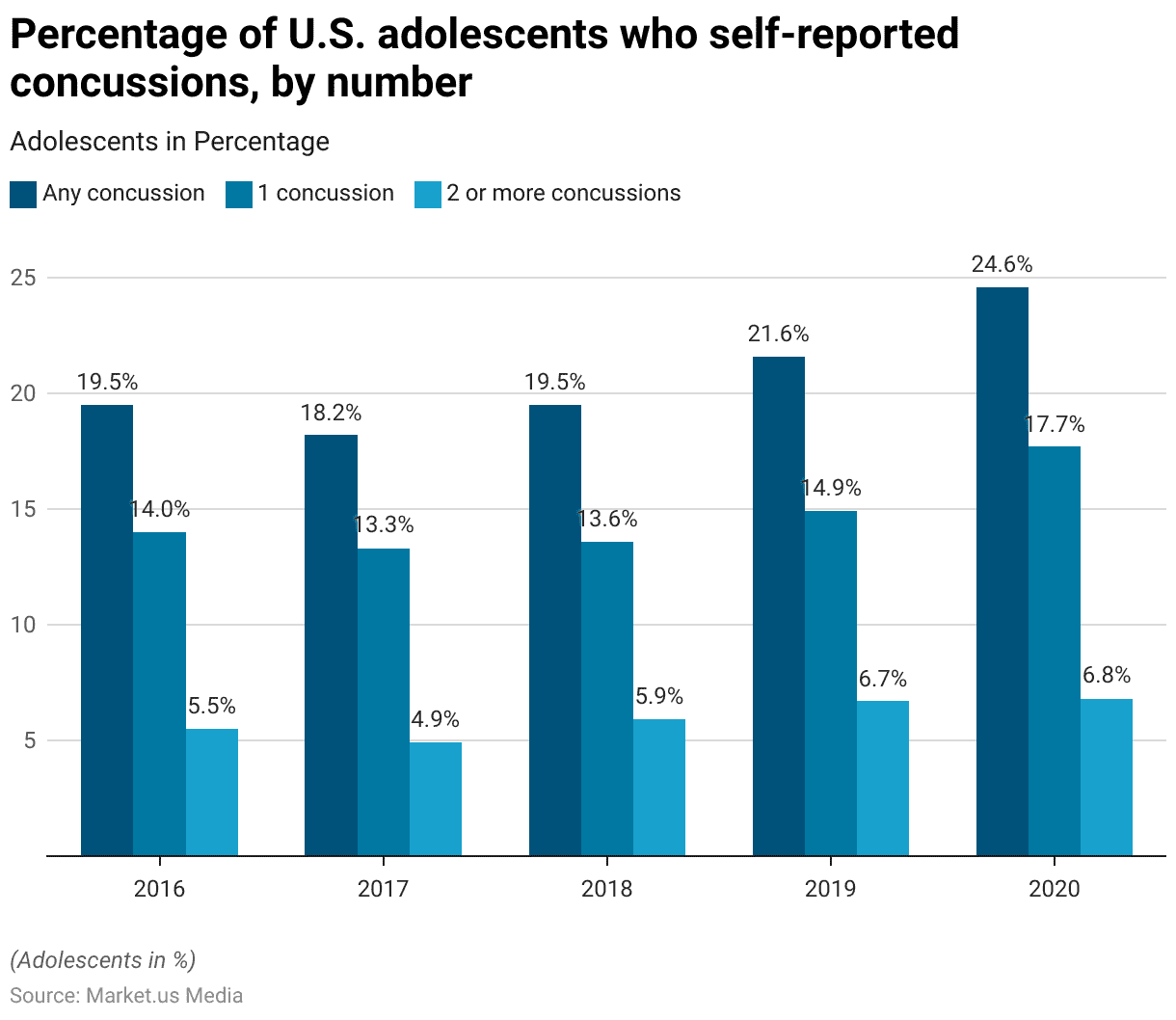
Sports Concussion in Students Statistics
High School
- The percentage of high school students in the United States who reported having a concussion from playing sports or being physically active showed a slight decline from 2017 to 2021.
- In 2017 and 2019, the percentage remained consistent at 15.1%.
- However, by 2021, this figure decreased to 11.9%, indicating a reduction in the reported incidence of concussions among high school students during this period.
(Source: Statista)
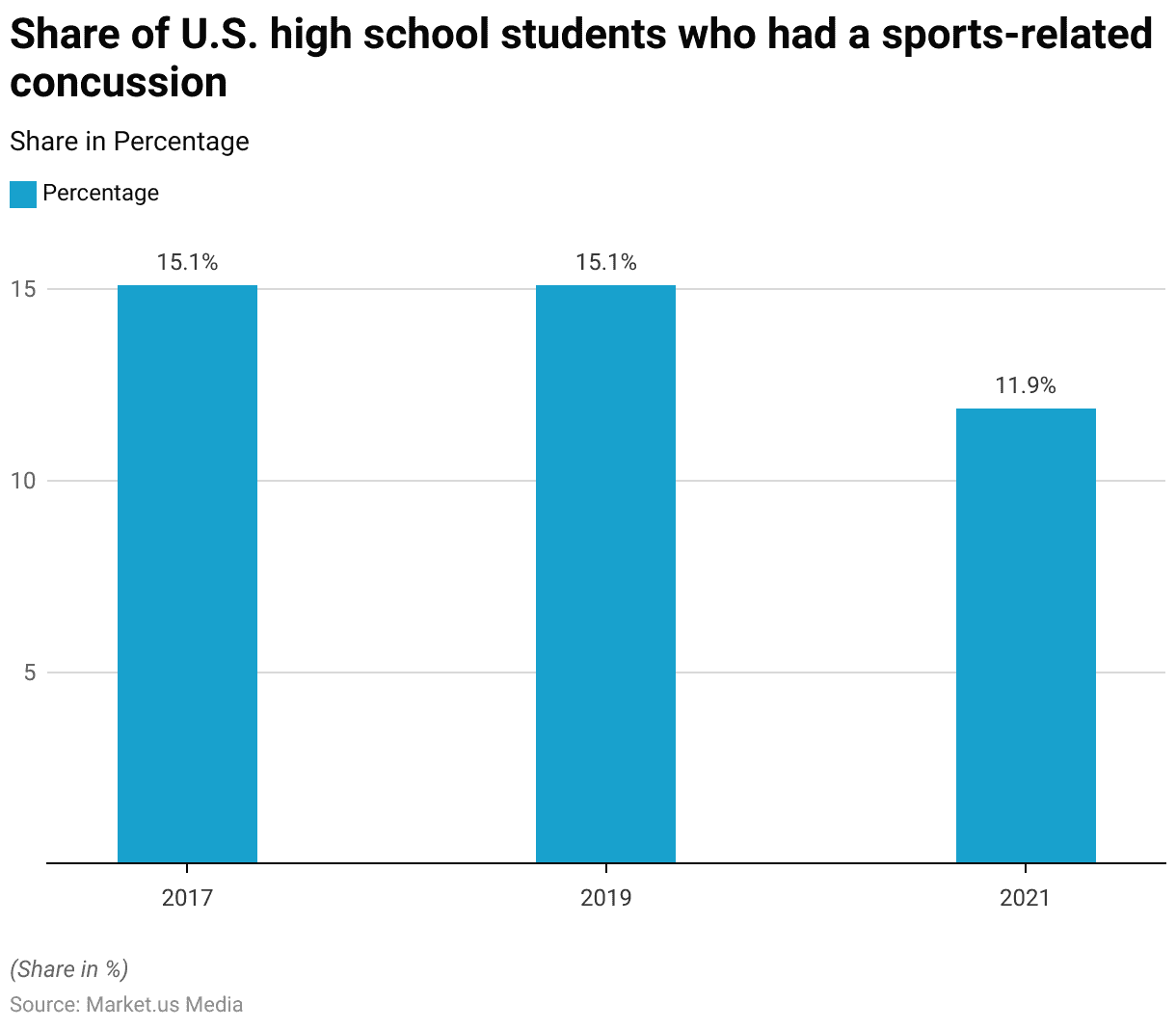
By Grade
- As of 2017, the percentage of U.S. students in grades 9 through 12 who suffered concussions from playing sports varied slightly by grade level.
- The majority of students reported having no concussions, with 83% of 9th graders, 84.8% of 10th graders, 84.7% of 11th graders, and 87.8% of 12th graders indicating they had not experienced a concussion.
- The percentage of students reporting one concussion decreased as grade level increased. With 11.3% of 9th graders, 8.5% of 10th graders, 9.6% of 11th graders, and 6.8% of 12th graders reporting one concussion.
- The incidence of students who reported having two concussions was relatively stable across the grades, ranging from 2.5% to 3.2%.
- A smaller proportion of students reported having three concussions. With less than 1.5% across all grades, specifically 0.9% in 9th and 11th grades, 1.4% in 10th grade, and 0.7% in 12th grade.
- Lastly, the percentage of students who experienced four or more concussions was fairly consistent, with around 1.8% to 2.1% across the grades.
- Overall, the data suggests a slight decline in the reported number of concussions as students progress through high school.
(Source: Statista)

In High School Games
- During the 2013-2014 school year, the incidence of concussions in U.S. high school sports varied significantly across different sports, measured per 10,000 players.
- Football (boys) had the highest rate of concussions, with 33 concussions per 10,000 players. Soccer (girls) followed, with a concussion rate of 18 per 10,000 players.
- Wrestling (boys), soccer (boys), and basketball (girls) each had a concussion rate of 12 per 10,000 players.
- This data highlights that boys’ football had the highest incidence of concussions among high school sports during this period. While both boys’ and girls’ soccer, along with wrestling and girls’ basketball, also presented notable risks.
(Source: Statista)
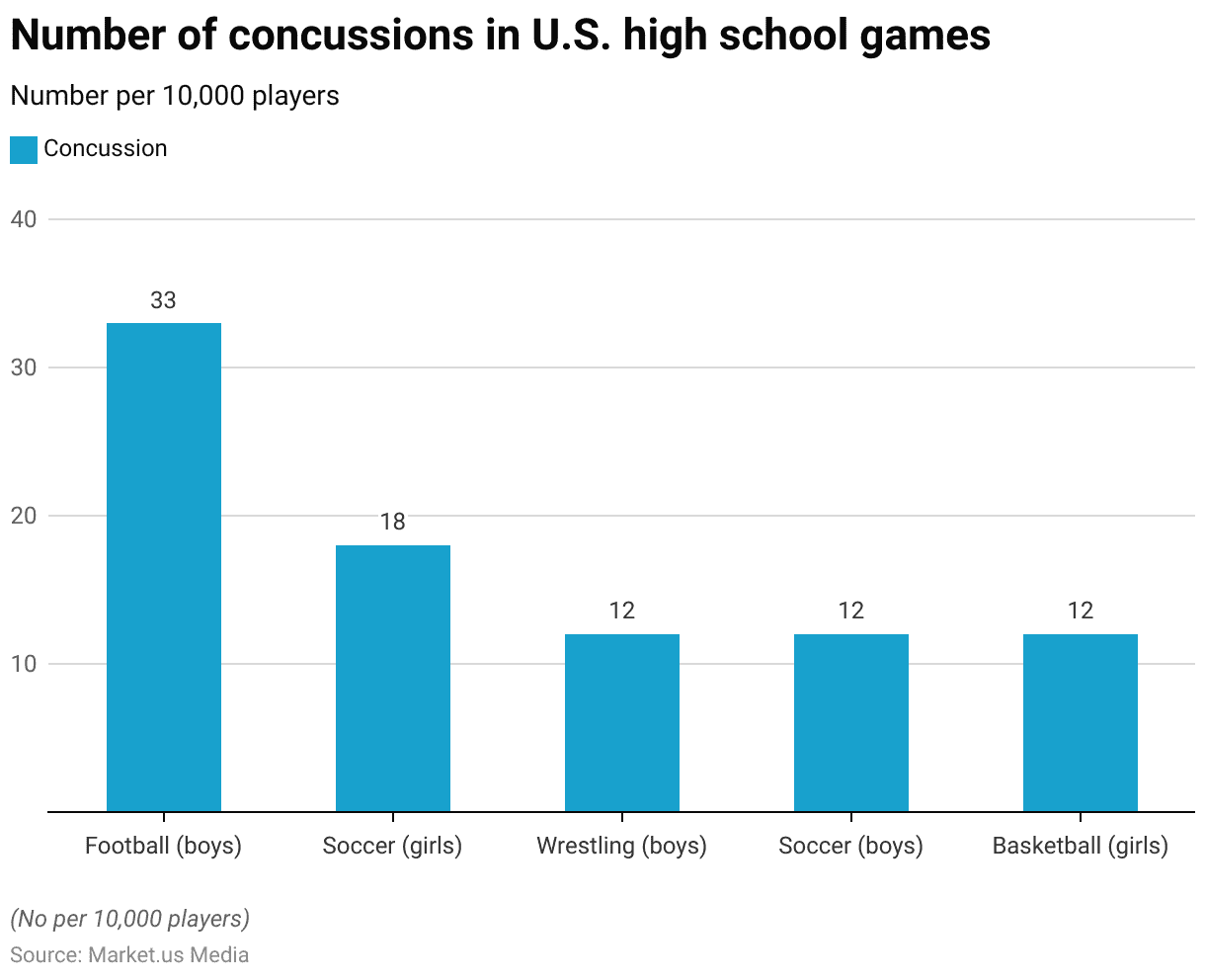
Demographic Insights
Age
- A survey of Canadians reporting concussions while playing sports revealed varying responses across different age groups.
- Among those aged 18-34, 42% reported having experienced a concussion, while 58% did not.
- In the 35-54 age group, 36% reported a concussion, with 64% indicating they had not.
- The 55+ age group had the lowest reported incidence, with only 16% indicating they had experienced a concussion, while 84% reported they had not.
- This data suggests that younger Canadians are more likely to report having experienced a concussion from sports activities compared to older age groups.
(Source: Angus Reid)
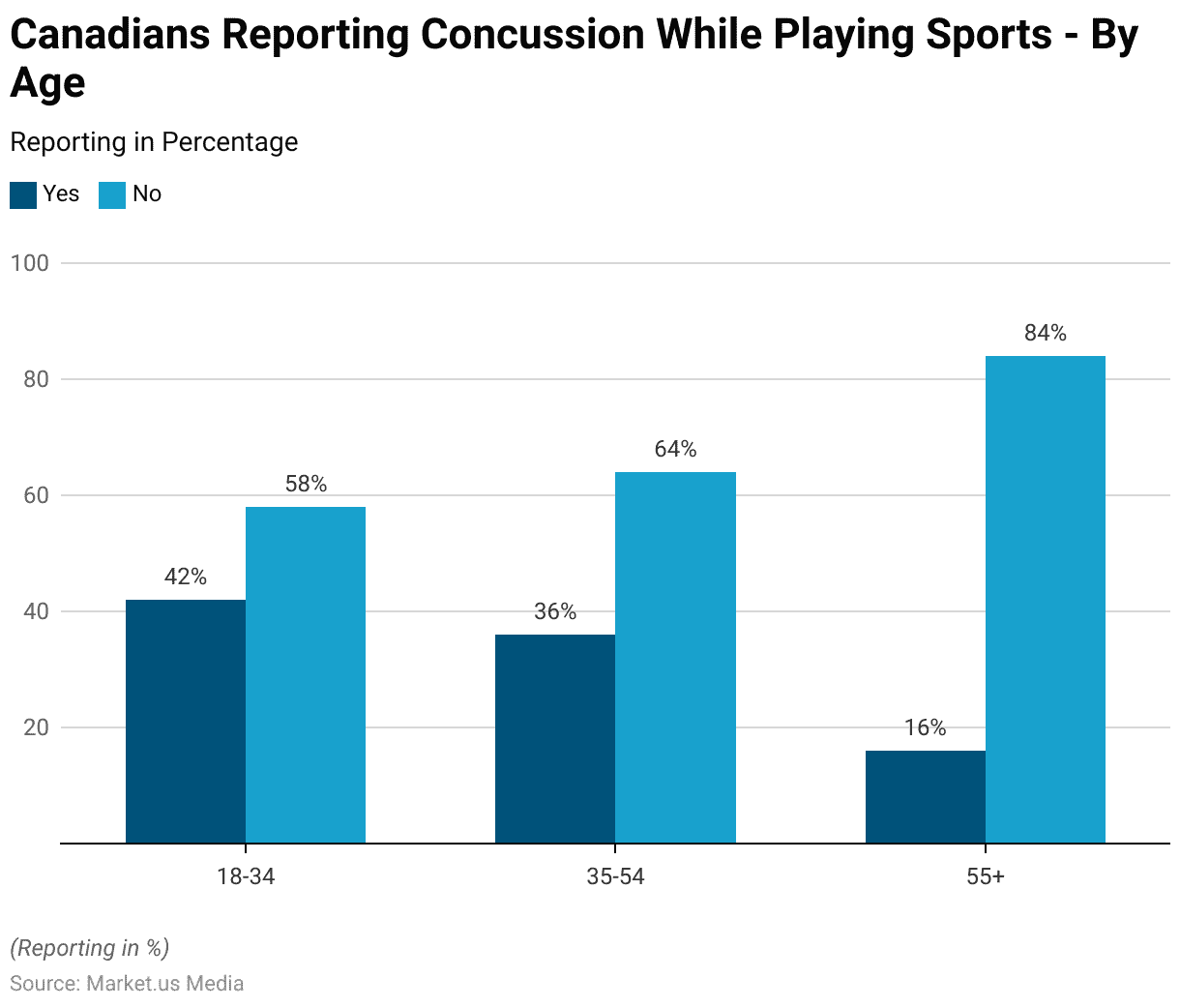
Gender
- As of 2017, data on U.S. students in grades 9-12 revealed differences in the incidence of concussions from playing sports based on gender.
- Among female students, 87% reported having no concussions, while 82.9% of male students reported the same.
- A higher percentage of male students reported experiencing concussions. With 10.2% indicating they had one concussion compared to 8% of females.
- Additionally, 3.3% of male students reported having two concussions, compared to 2.6% of female students.
- The trend continued, with 1.2% of male students reporting three concussions, compared to 0.8% of females.
- Finally, 2.4% of male students reported having four or more concussions. While 1.5% of female students reported the same.
- Overall, male students were slightly more likely than female students to report experiencing multiple concussions from sports activities.
(Source: Statista)
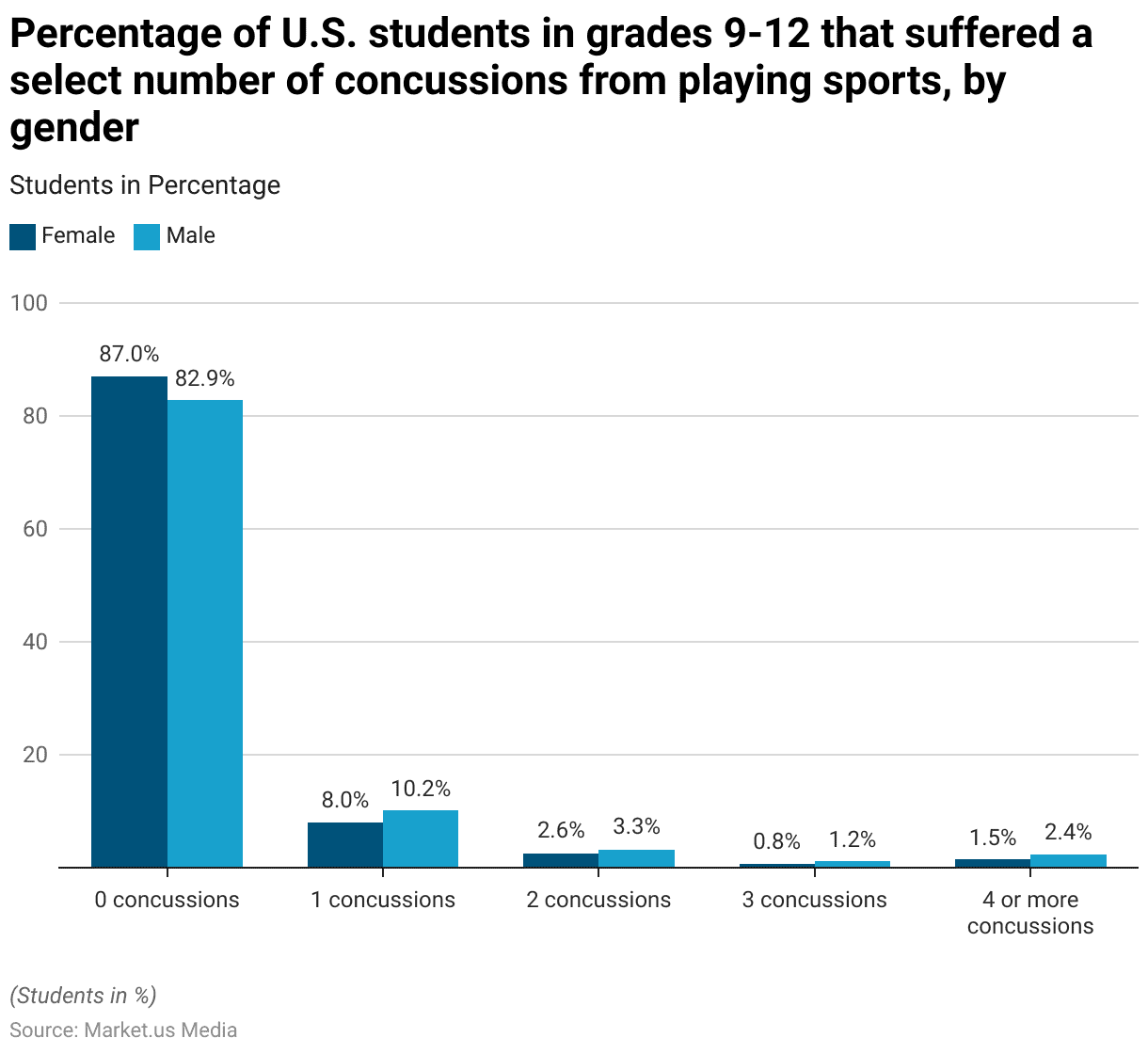
Ethnicity
- As of 2017, the incidence of concussions among U.S. students in grades 9-12 varied by ethnicity.
- Among White, non-Hispanic students, 85.4% reported having no concussions, similar to 85.1% of Hispanic students and slightly higher than 83% of Black, non-Hispanic students.
- The percentage of students who reported experiencing one concussion was 9.7% among White, non-Hispanic students, compared to 8.2% for both Black, non-Hispanic, and Hispanic students.
- When it came to students reporting two concussions, the percentages were 3.4% for Hispanic students, 3.3% for Black, non-Hispanic students, and 2.6% for White, non-Hispanic students.
- For students who reported experiencing three concussions, 1.7% were Black, non-Hispanic, 0.9% were White, non-Hispanic, and 0.9% were Hispanic.
- The data showed that 3.7% of Black, non-Hispanic students reported having four or more concussions, which was higher than the 2.7% of Hispanic students and 1.3% of White, non-Hispanic students who reported the same.
- These figures indicate that while the majority of students across all ethnicities reported no concussions, there were noticeable differences in the incidence of multiple concussions, with Black, non-Hispanic students reporting a higher rate of multiple concussions compared to their peers.
(Source: Statista)
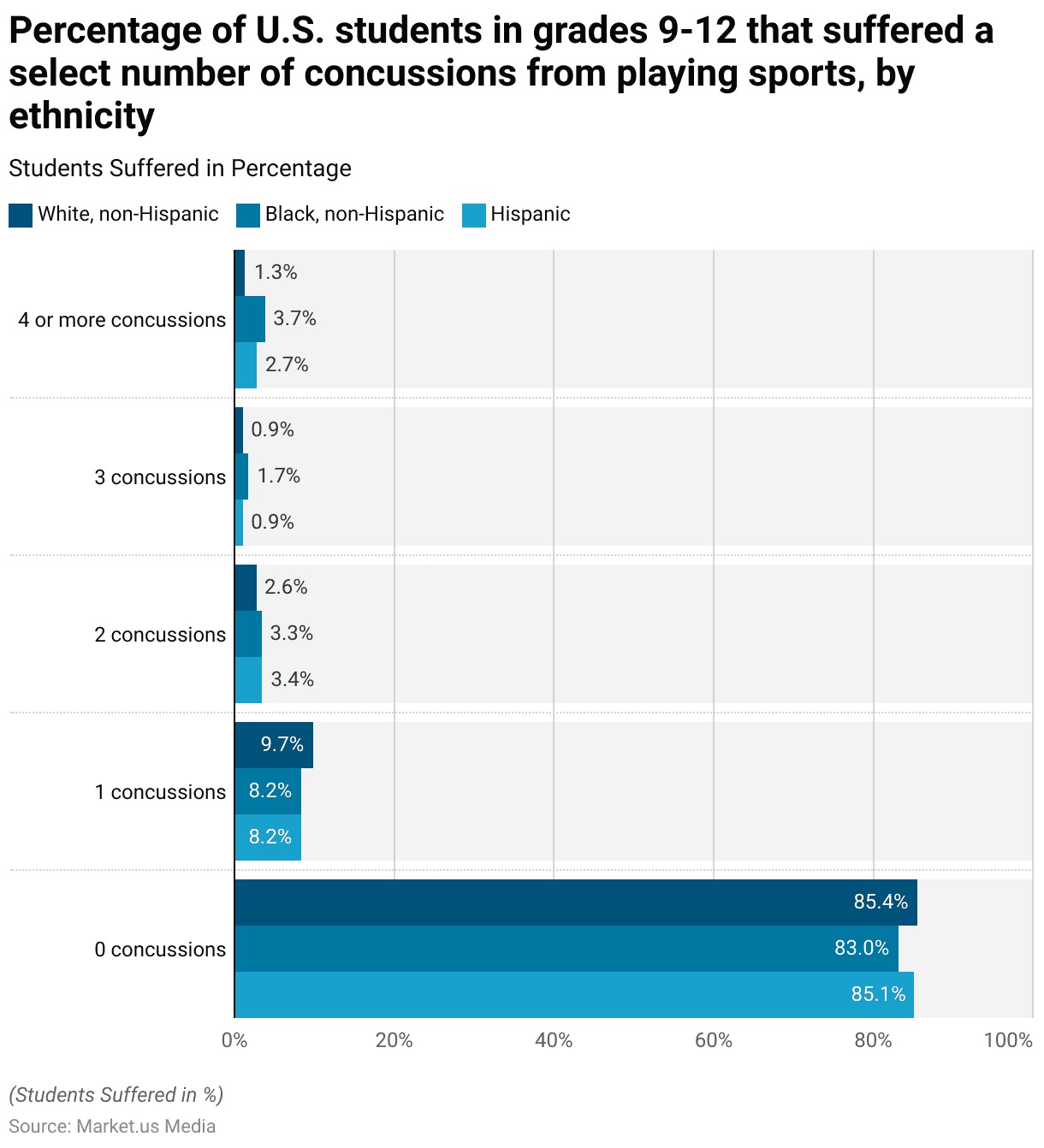
Rugby Sports Concussion Statistics
By Team
High to Average
- Between 2013 and 2015, the average number of reported concussions in the NFL varied significantly by team.
- The Cincinnati Bengals had the highest average, with 17 reported concussions, followed closely by the Cleveland Browns with 16.7.
- The San Diego Chargers reported an average of 14.7 concussions, while both the Oakland Raiders and Jacksonville Jaguars had an average of 12.7.
- Several teams, including the Indianapolis Colts, Denver Broncos, and Kansas City Chiefs, reported an average of 11 concussions each.
- The Minnesota Vikings and San Francisco 49ers both reported an average of 10.7 concussions, while the Detroit Lions had 10.3.
- Teams such as the New England Patriots, Washington Redskins, New York Jets, and St. Louis Rams each averaged ten concussions.
- The Baltimore Ravens reported 9.7 concussions, slightly above the NFL average of 9.5 during this period.
Average to Low
- The Houston Texans followed with an average of 9.3, and several teams, including the Green Bay Packers, Tennessee Titans, and New York Giants, reported an average of 9 concussions each.
- Teams with lower averages included the Seattle Seahawks (8.3), New Orleans Saints (8), Philadelphia Eagles (7.7), and Dallas Cowboys (7.7).
- The Pittsburgh Steelers and Chicago Bears each reported an average of 7.3 concussions, while the Tampa Bay Buccaneers averaged 7.
- The Arizona Cardinals and Carolina Panthers both had an average of 6.3 concussions, followed by the Buffalo Bills with 5.7, the Atlanta Falcons with 5, and the Miami Dolphins with the lowest average of 3.3 concussions.
- Overall, this data indicates a wide range of concussion reporting across NFL teams, with some teams reporting significantly higher averages than others during the 2013-2015 period.
(Source: StatNews)
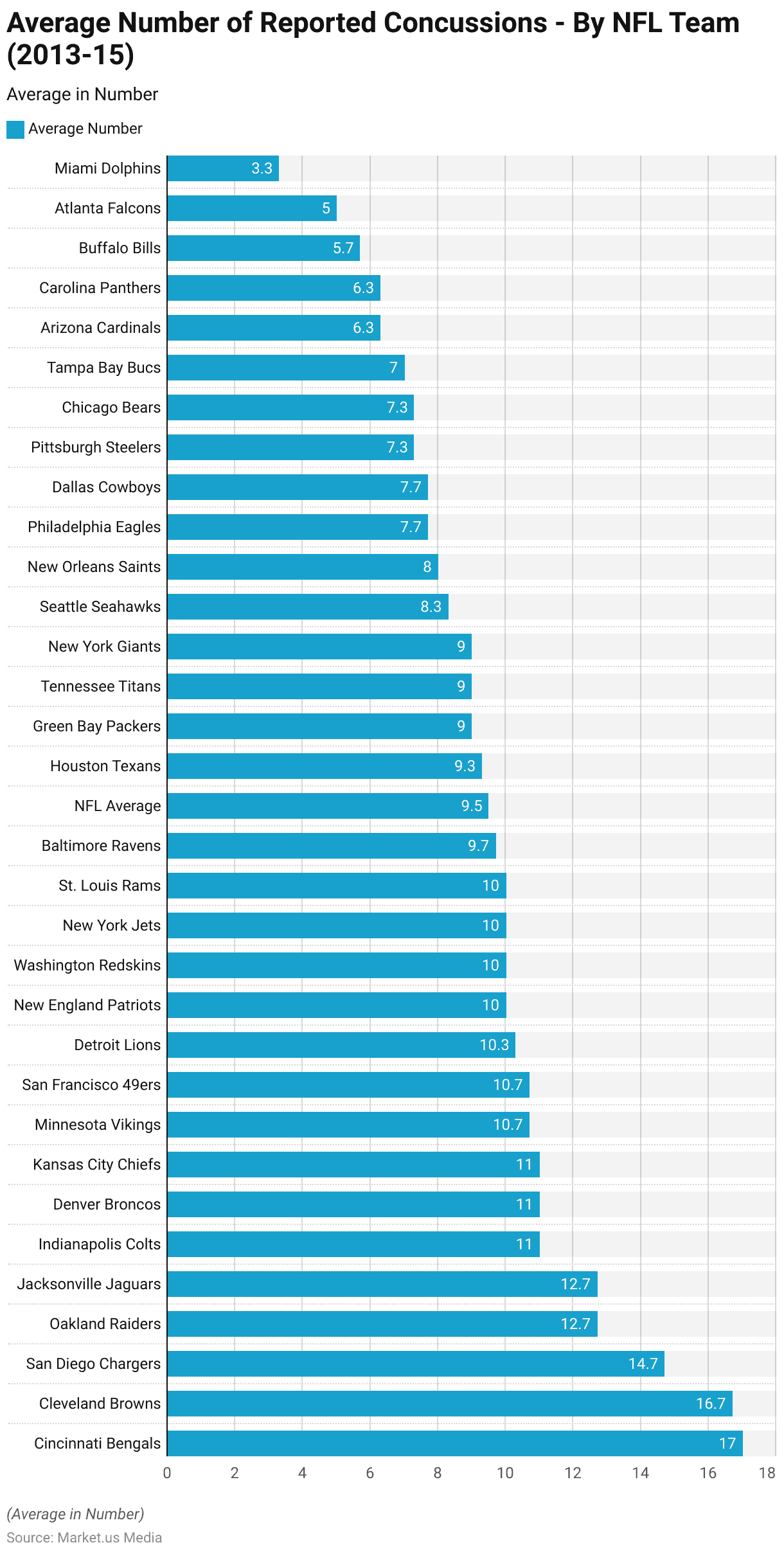
Match Concussion Injury Incidents – By Time-loss
- In the 2018/2019 season, the Rugby Football Union (RFU) recorded the number of match concussion injury incidents per 1,000 hours played, categorized by the time lost due to injury.
- The data revealed that the highest incidence rate occurred when the time-loss was between 8-28 days, with 9.9 incidents per 1,000 hours played.
- This was followed by a time loss of 2-7 days, which had an incidence rate of 7.5 per 1,000 hours played.
- The incidence rate significantly decreased for longer time-loss periods, with 1.8 incidents per 1,000 hours played recorded for a time-loss of 29-84 days and the lowest rate of 1.2 incidents per 1,000 hours played for time-losses of 84 days or more.
- This data indicates that most concussion injuries in rugby during this period resulted in short to medium-term time loss, with fewer incidents leading to extended absences from play.
(Source: Statista)
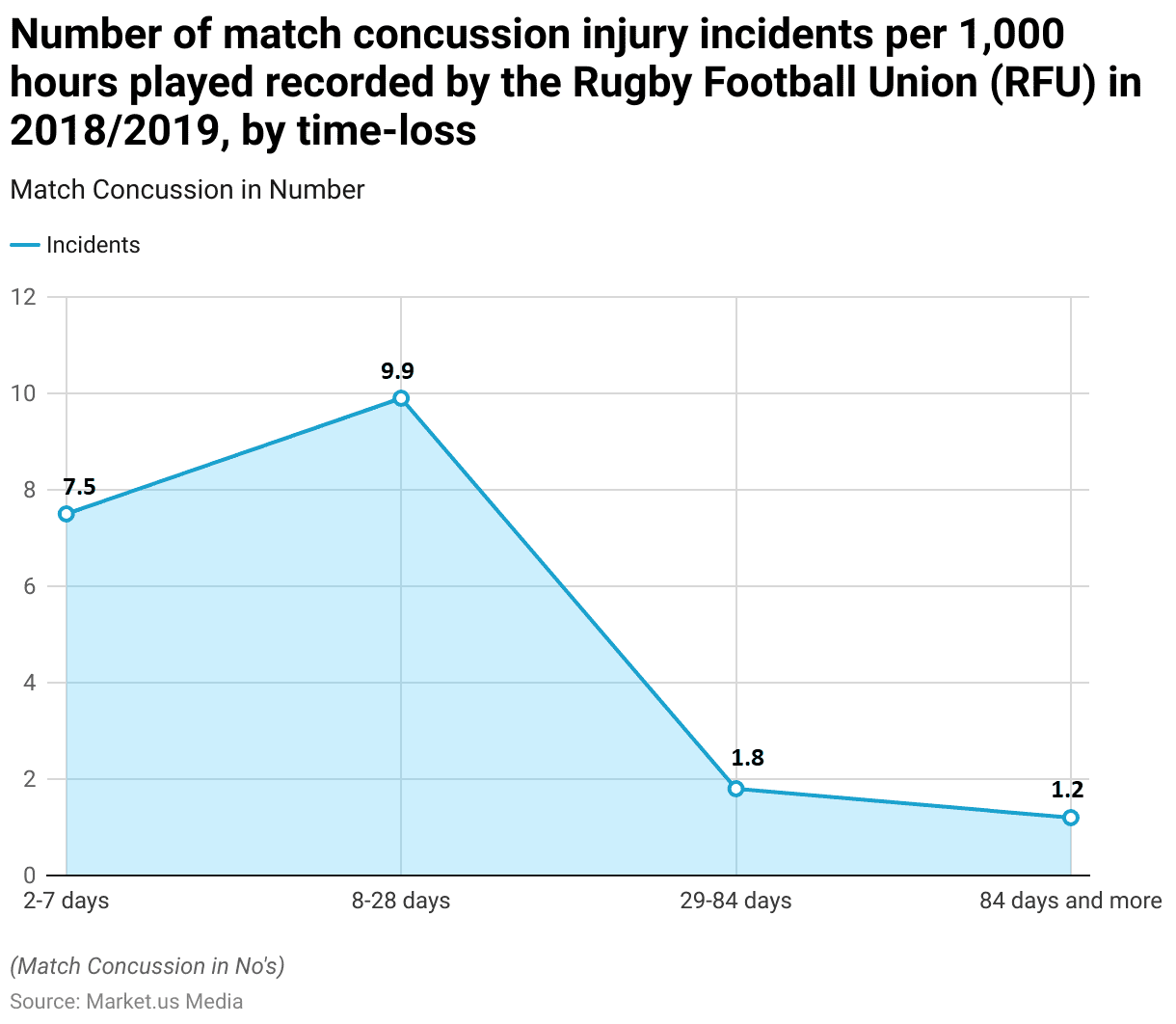
Consumers’ Opinion On Responsibility for Identifying Concussions in the NFL
- In 2017, U.S. consumers expressed varying opinions on who is most responsible for identifying concussion symptoms and ensuring that a player gets tested during an NFL game.
- The majority of respondents, 48%, believed that the team’s medical staff, such as athletic trainers and team physicians, should bear this responsibility.
- Another 19% of respondents felt that all parties involved share equal responsibility.
- On-site third-party athletic trainers or specialists were identified by 10% of respondents as the primary responsible party.
- A smaller portion of the respondents, 8%, believed that the player himself should be responsible for identifying symptoms.
- The coaching staff, including head coaches and positional coaches, was considered responsible by 6% of respondents.
- Only 3% of respondents thought that referees or on-site league officials were responsible, and an equal percentage (3%) believed that no one was responsible.
- Another 3% felt that other players on the team should be responsible.
- This data highlights that most consumers see the responsibility for concussion identification and testing as primarily lying with the team’s medical staff.
- However, some believe it should be a shared duty among various stakeholders.
(Source: Statista)
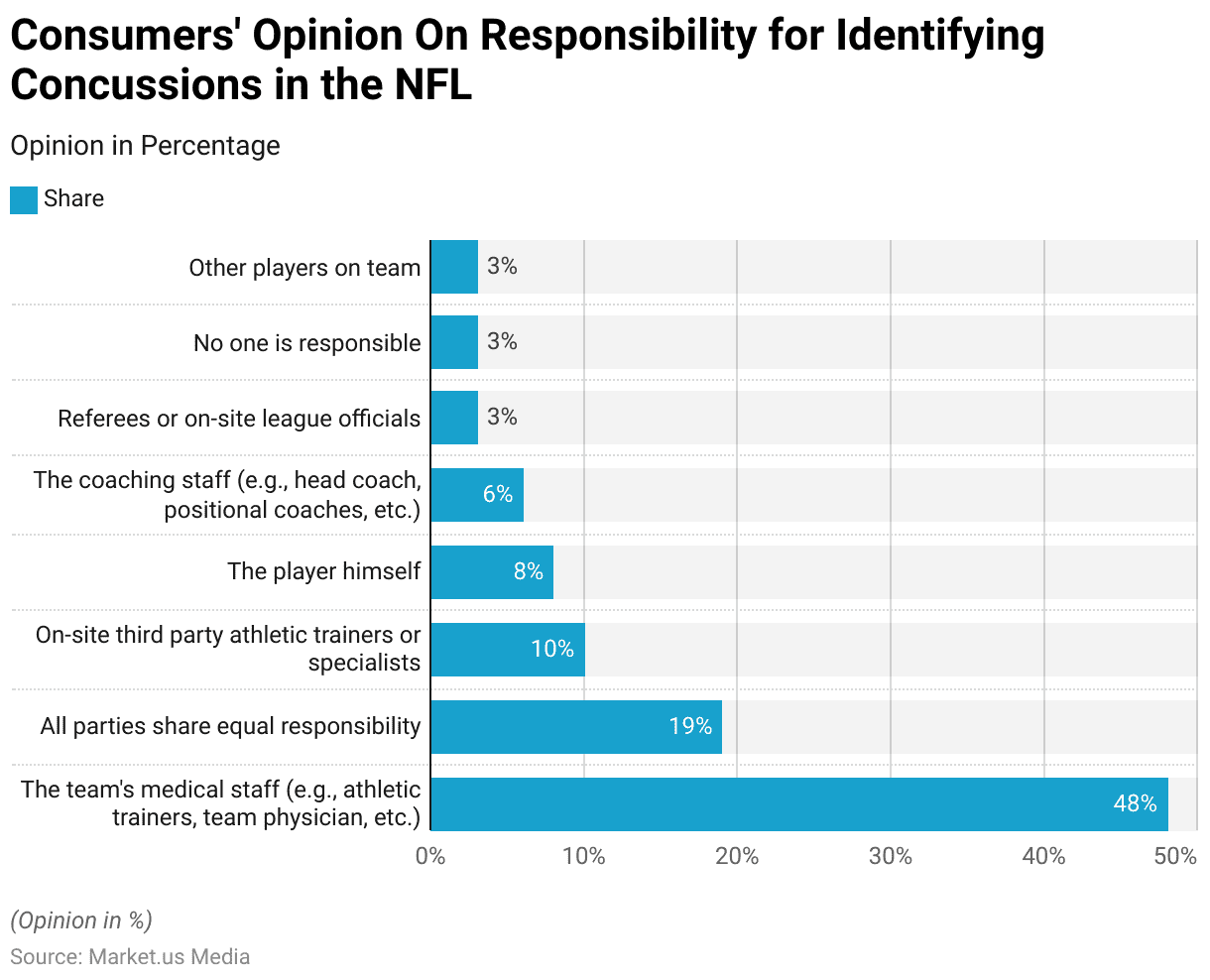
Soccer Sports Concussion Statistics
Boys Soccer Sports Concussion Sources Statistics
- In boys’ soccer, the primary source of concussions was contact with another player, accounting for 68.8% of all reported incidents.
- Contact with the playing surface was responsible for 13.3% of concussions, while 17% resulted from contact with playing apparatus, including the ball.
- This data underscores that the majority of concussions in boys’ soccer arise from player-to-player interactions.
(Source: The Washington Post)
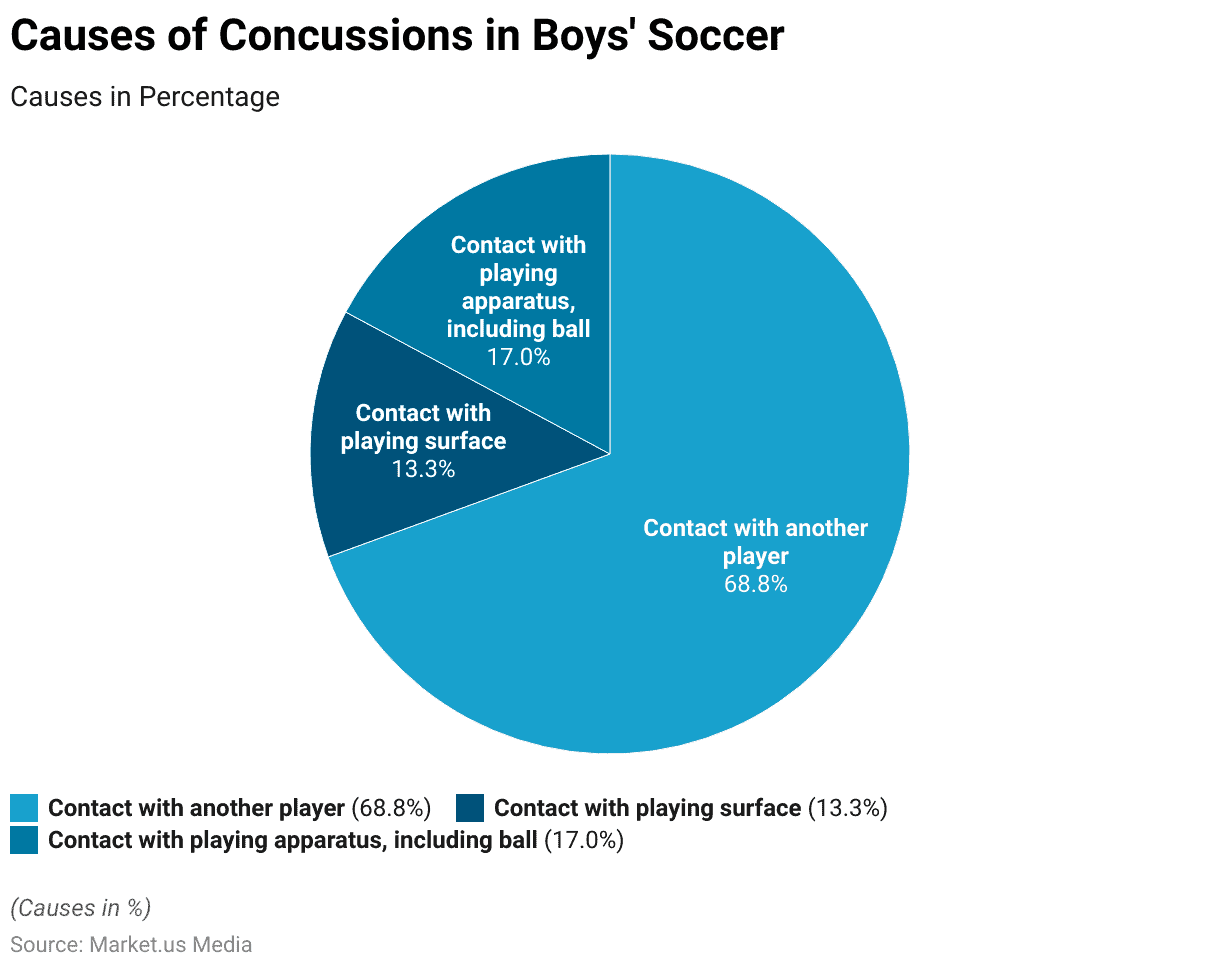
Incidences of Sports Concussion Among Soccer Players – By Gender Statistics
- The incidence of concussions among soccer players, as recorded in a survey, showed a decline over the three school years from 2016 to 2019.
- During the 2016-2017 school year, 349 concussions were reported among girls, compared to 205 among boys.
- The following year, 2017-2018, saw a decrease in reported concussions, with 305 cases among girls and 163 among boys.
- This declining trend continued in the 2018-2019 school year, where 296 concussions were reported for girls and 189 for boys.
- Overall, the data indicates a decrease in concussion incidences over the three years, with girls consistently reporting more concussions than boys each year.
(Source: Nature)

Public Opinion on Concussion Suffered in Sports and Long-Term Brain Damage Effects Statistics
- A 2014 survey explored public opinion on various aspects of concussion prevention and the potential for long-term brain damage in sports.
- The majority of respondents strongly agreed with several key statements: 60% believed that players who suffer a head injury should be required to take a minimum set amount of time off to recover. In comparison, 61% felt that helmets should be improved to better protect against concussions.
- Additionally, 57% supported the idea of a standardized test to determine when injured players may return to the field.
- Opinions were also strong regarding the risks associated with football, with 49% strongly agreeing that these risks are widely known and that players participate at their own risk.
- When it came to the issue of aggressive tackles in youth football, which could lead to head injuries, 54% strongly agreed that such actions should be restricted.
- However, there was less consensus on the effectiveness of the rules instituted in 2010 to limit head injuries.
- Only 9% strongly agreed that these rules have been effective, while 36% somewhat agreed, and a notable 33% were not at all sure of their impact.
- This data highlights significant public concern regarding the management and prevention of concussions in sports, as well as mixed opinions on the effectiveness of current regulations.
(Source: Statista)
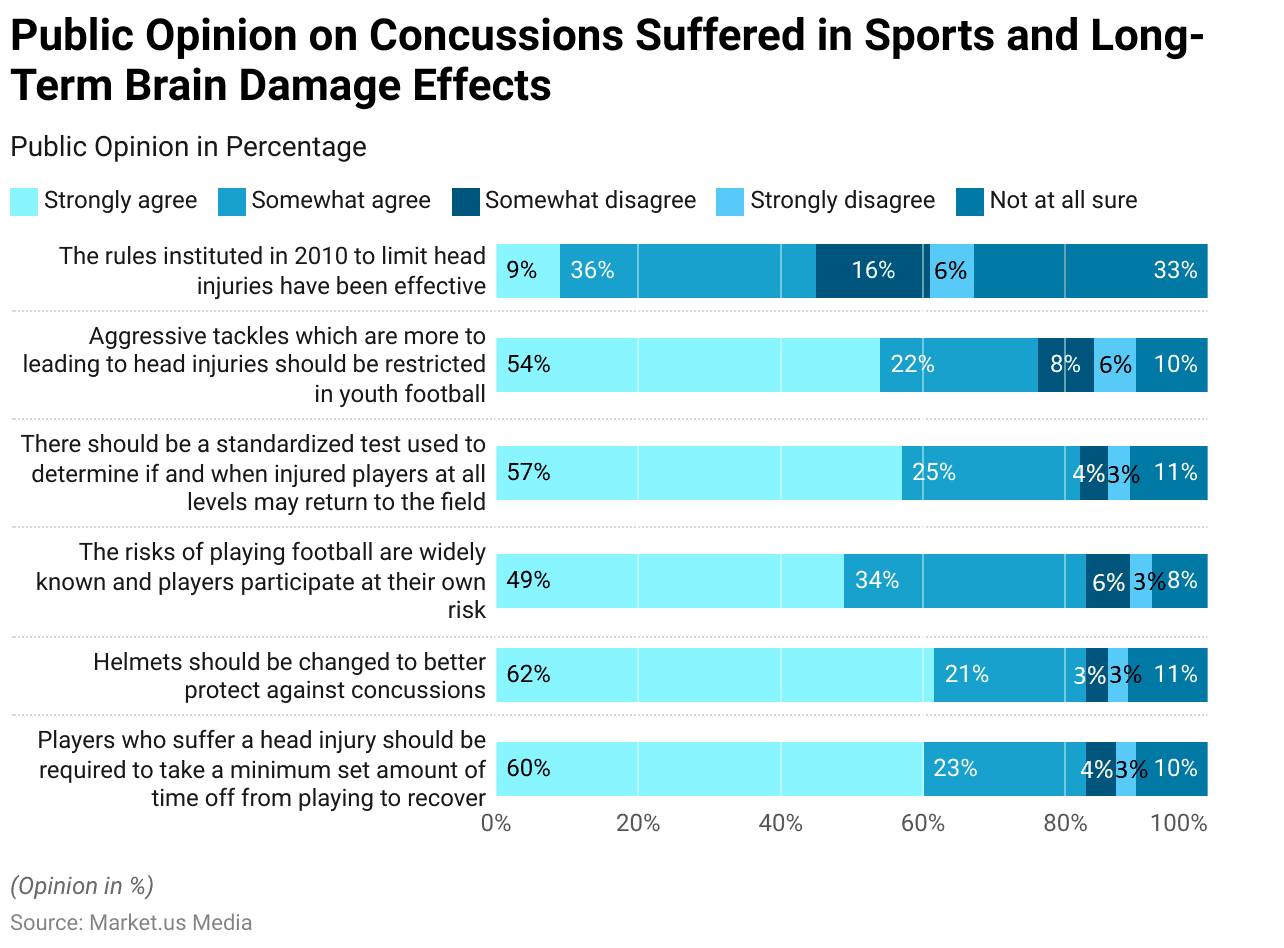
Post-Sports Concussion Syndrome Statistics
- From 2010 to 2015, the percentage of individuals in the United States who experienced post-concussion syndrome (PCS) after a concussion increased across all age groups.
- Among children younger than ten years, the incidence of PCS rose from 2.5% in 2010 to 4.5% in 2015.
- The 10 to 19-year-old age group saw a similar upward trend, with the percentage increasing from 8% in 2010 to 12.4% in 2015.
- Adults aged 20 to 64 years experienced the most significant increase, with the incidence of PCS rising from 7.8% in 2010 to 15.7% in 2015.
- These data suggest a growing recognition and Diagnosis of post-concussion syndrome across all age groups over these five years.
(Source: Statista)
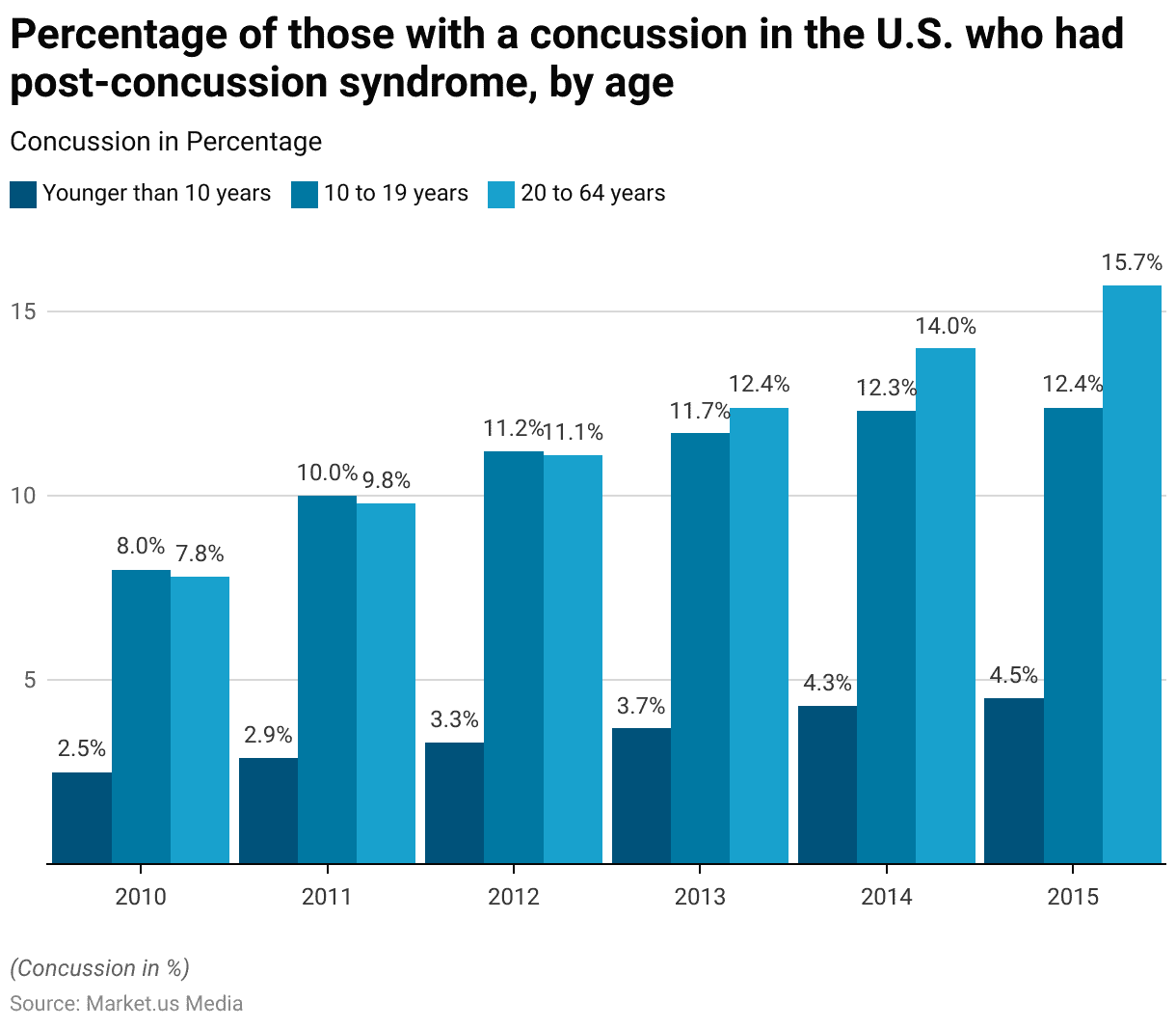
Impact on Viewership
- As of October 2022, public interest in watching National Football League (NFL) games in the United States appeared to be influenced differently across generations by the occurrence of players sustaining head injuries.
- Among all adults, 71% reported that such injuries had no impact on their interest in watching NFL games, while 21% were somewhat less interested, and 9% were much less interested.
- Generation Z (GenZers) exhibited the most sensitivity to head injuries. With only 62% stating that these incidents had no impact on their interest. In comparison, 30% were somewhat less interested, and 8% were much less interested.
- Millennials also showed a notable level of concern, with 64% reporting no impact, 25% somewhat less interested, and 12% much less interested.
- Generation X (GenXers) and Baby Boomers were less impacted by players sustaining head injuries. Among GenXers, 73% reported no impact on their viewing interest, 19% were somewhat less interested, and 8% were much less interested.
- Baby Boomers showed the least concern, with 78% stating no impact, 16% somewhat less interested, and only 6% much less interested.
- This data indicates that younger generations are more likely to reduce their interest in watching NFL games due to concerns over head injuries than older generations.
(Source: Statista)
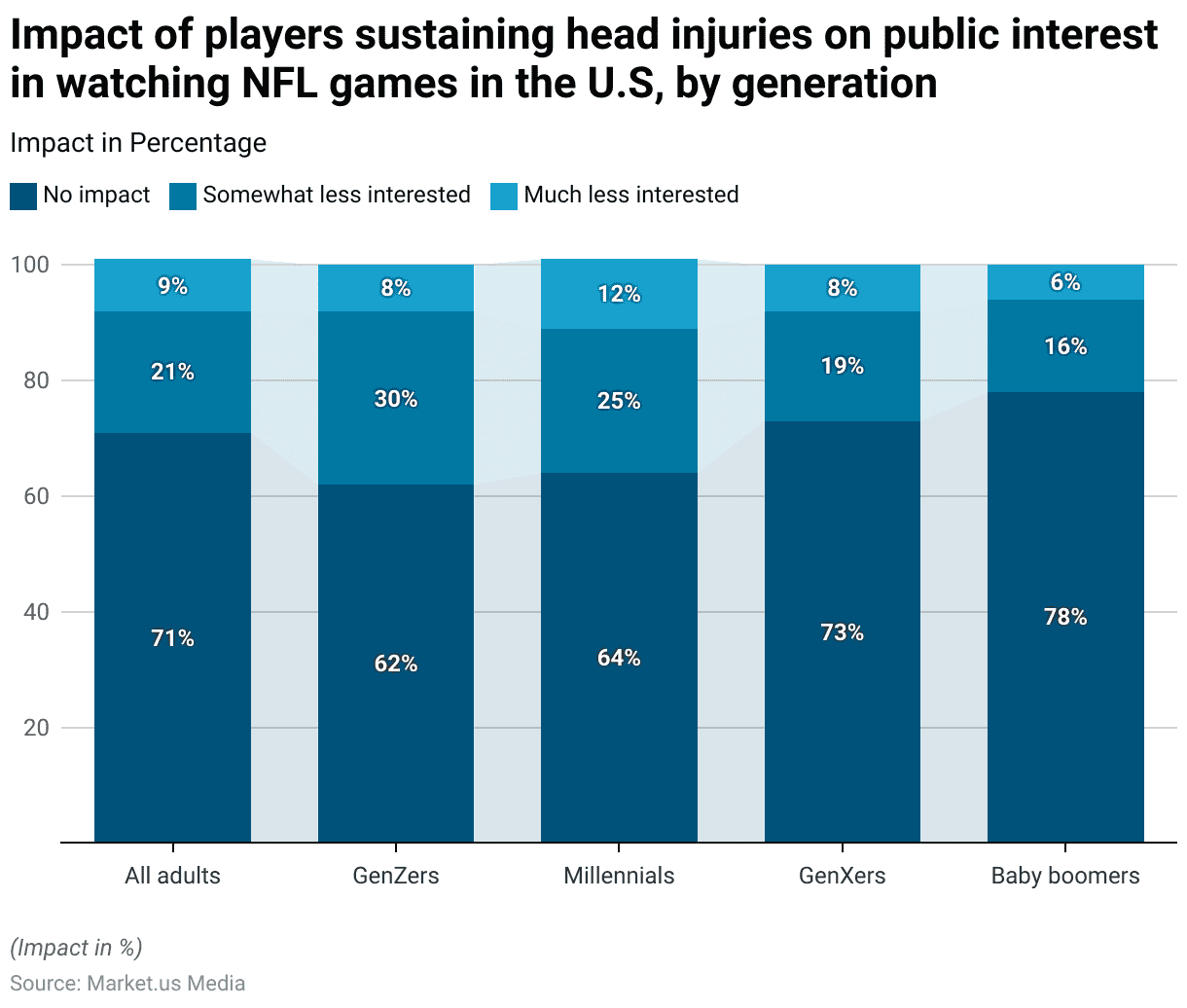
Remedies and Policies for Treating Concussion in Sports Statistics
Public Support for Concussion Related Policies in Youth Sports Statistics
- A survey conducted in Canada revealed strong public support for several policies aimed at managing and preventing concussions in youth sports.
- A significant majority, 95%, supported requiring coaches to be educated on the risks of concussions as a condition of their eligibility to coach, with only 5% opposing this policy.
- Similarly, 92% of respondents supported both the requirement for young athletes to follow a “Return to Play” policy after a suspected concussion and the requirement for young athletes to obtain a doctor’s permission before returning to sports. Only 8% opposed these measures.
- There was also considerable support (72%) for the requirement that a certified trainer or health professional be present at every organized youth game. Although 28% of respondents opposed this policy.
- However, public opinion was more divided on the issue of not allowing kids under the age of 14 to play contact sports. A minority of 43% supported this policy, while a majority of 57% opposed it.
- This data indicates a strong consensus in favor of concussion prevention measures. However, restrictions on contact sports for younger children remain more contentious.
(Source: Angus Reid)

Banning Contact Sports for Children Under 14
- Support for the policy of not allowing children under the age of 14 to play contact sports varies across Canadian provinces, with overall national support at 43%.
- Quebec shows the highest level of support, with 58% of respondents in favor of the policy.
- In contrast, support is significantly lower in other provinces, particularly in Alberta and Saskatchewan, where only 32% and 30% of respondents, respectively, support the ban.
- British Columbia and Ontario have similar levels of support at 42% and 40%. While Manitoba and Atlantic Canada show support levels of 39% and 38%, respectively.
- This data suggests that while there is some support for the policy across Canada, regional differences are pronounced. Quebec shows the strongest backing for restricting contact sports among younger children.
(Source: Angus Reid)
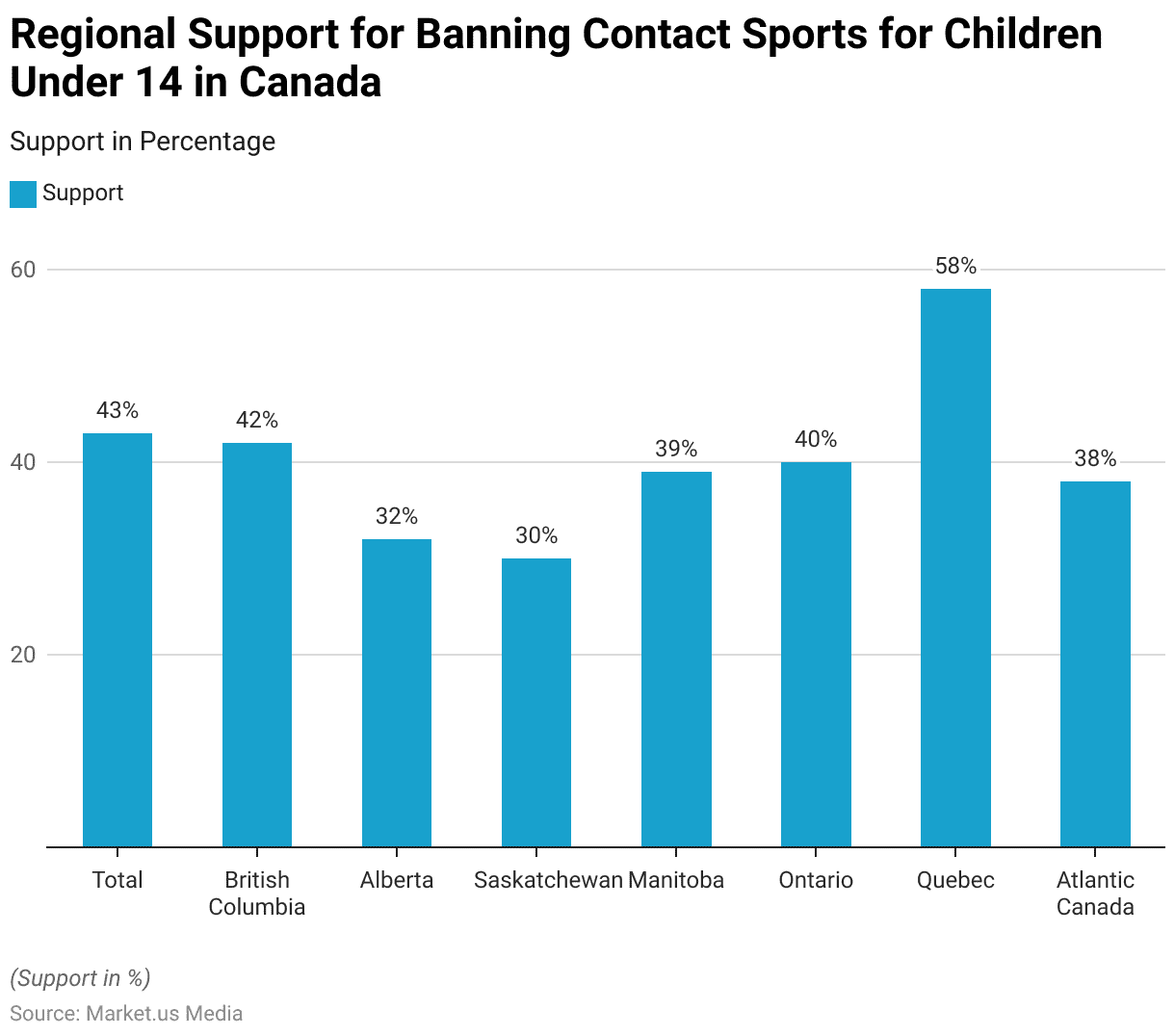
Initiatives to Counter Sports Concussion Statistics
- Efforts to address sports-related concussions have intensified across various sports organizations worldwide. Focusing on prevention, early detection, and effective management of these injuries.
- Recent international guidelines, such as those emerging from the 2023 Amsterdam International Consensus on Concussion in Sport. It has been pivotal in updating protocols and tools to aid in the recognition and management of concussions.
- Key initiatives include rule changes to reduce high-impact collisions. Such as disallowing body-checking in youth hockey and limiting contact practice in American football.
- Furthermore, neuromuscular training and mandatory use of protective gear like mouthguards have been advocated to enhance safety.
- Countries like Canada have spearheaded national strategies, exemplified by the Pan-Canadian concussion strategy. Which integrates sport-specific protocols and educational resources for stakeholders, including coaches and parents.
- These initiatives are supported by updated assessment tools, such as the Concussion Recognition Tool 6 (CRT6) and the Sport Concussion Assessment Tool 6 (SCAT6), which are designed to improve early Diagnosis and tailor rehabilitation strategies.
- These comprehensive efforts are essential in mitigating the long-term health risks associated with concussions and ensuring safer sporting environments.
(Sources: Springer Link, CHEO Research Institute, The Sport Information Resource Centre)
Regulations for Sports Concussion Treatments Statistics
- Regulations for sports concussion treatments vary significantly across different countries. With increasing emphasis on prevention, management, and return-to-play protocols to safeguard athletes’ health.
- In the United Kingdom, recent guidelines advocate a “recognize, remove, and recover” approach. Emphasizing the immediate removal of an athlete suspected of having a concussion from play and recommending a gradual return to activities under medical supervision.
- In contrast, the United States has implemented laws such as Washington State’s Zackery Lystedt Law. Which mandates that any youth athlete suspected of a concussion must receive clearance from a licensed healthcare provider before returning to play.
- Australia has also updated its concussion management guidelines. Ensuring a consistent approach across all sports levels, focusing on comprehensive assessment tools like SCAT6.
- These regulations reflect a growing global commitment to reducing the long-term impacts of sports-related concussions through stringent, evidence-based practices.
- This shift towards standardized, rigorous concussion protocols across various countries underscores. The evolving recognition of the serious health risks associated with sports-related concussions and the importance of protecting athletes at all levels.
(Sources: GOV. U.K., WA Department of Health)
Technological Developments in Sports Concussion Treatments Statistics
- Technological advancements in the treatment of sports-related concussions have significantly evolved, focusing on improving Diagnosis, prevention, and recovery methods.
- Wearable technology, such as the FITGuard mouthguard and xPatch sensor. Provides real-time data on the force and angle of impacts, aiding in the early detection of concussions.
- Additionally, innovations like color-changing helmets, which visually indicate the severity of impacts, are enhancing safety measures in sports.
- The development of advanced neuroimaging and biomarker tests is also underway. Offering the potential for more accurate Diagnosis and monitoring of concussion recovery.
- Furthermore, guidelines now emphasize the benefits of early, light-intensity physical activity in recovery. Marking a shift from the previous strict rest protocols.
- These technologies and updated approaches are being integrated into sports at various levels. Reflecting a growing commitment to reducing the long-term impacts of concussions on athletes’ health.
(Sources: ScienceDaily, Smithsonian Magazine, CHEO Research Institute)
Recent Developments
New Product Launches:
- “C3 Logix” Introduces Advanced Concussion Monitoring System: In early 2024, C3 Logix launched a new concussion assessment tool designed to improve the accuracy of diagnosing concussions in athletes. This system integrates advanced neurocognitive testing and real-time monitoring capabilities, enhancing the ability to track recovery and manage risks.
- “Q-Collar” Receives FDA Approval: In late 2023, the Q-Collar, a wearable device designed to reduce the risk of concussions by stabilizing the brain during impact, received FDA approval for use in contact sports. This innovation aims to provide an additional layer of protection for athletes in high-risk sports.
Acquisitions and Mergers:
- “ImPACT Applications” Acquires “Cogstate”: In 2023, ImPACT Applications, a leading provider of concussion management tools. Acquired Cogstate, a cognitive testing company, for $150 million. This acquisition is expected to enhance ImPACT’s concussion assessment capabilities and integrate advanced cognitive testing into its platform.
- “HeadCheck Health” Merges with “Athlete Monitoring Systems”: In early 2024, HeadCheck Health, a company specializing in concussion management software, merged with Athlete Monitoring Systems. This merger aims to create a comprehensive concussion management and athlete health monitoring platform, leveraging combined technologies and resources.
Funding:
- “Fend” Secures $25 Million in Series A Funding: In 2024, Fend, a startup developing innovative concussion prevention technology, raised $25 million in Series A funding. The funds will be used to advance their concussion prevention devices and expand their research into brain injury mitigation.
- “Sotera Health” Raises $40 Million for Concussion Research: Sotera Health, a company focused on sports-related concussion research. Secured $40 million in funding to support its ongoing studies into new concussion treatment methods and technologies. The funding aims to accelerate the development of more effective concussion management solutions.
Technological Advancements:
- AI-Powered Concussion Detection Tools: New AI-driven concussion detection tools are being developed to improve the accuracy of diagnosing and monitoring concussions. By 2025, it is projected that AI-based tools will account for 30% of the market for concussion detection and management solutions. Reflecting a significant trend toward integrating artificial intelligence into sports medicine.
- Wearable Technology for Concussion Prevention: The use of wearable technology, such as impact-absorbing headgear and monitoring devices, is on the rise. In 2024, the market for concussion prevention wearables is expected to grow by 15%. Driven by increasing awareness and demand for athlete safety
Market Dynamics:
- Growth in the Concussion Management Market: This growth is attributed to increased awareness of concussion risks. Advancements in diagnostic and prevention technologies, and rising adoption of concussion management programs.
- Increased Emphasis on Youth Sports Safety: There is a growing focus on improving concussion protocols and safety measures in youth sports. In 2024, it is anticipated that 60% of sports organizations will implement new concussion management policies for youth athletes. Reflecting heightened concern over long-term brain health.
Conclusion
Sports Concussion Statistics – Sports concussions are a significant concern, particularly in contact sports like football, boxing, and soccer.
Public opinion strongly supports better education for coaches, stricter “Return to Play” policies, and medical clearance for athletes.
Despite increased awareness, the rising prevalence of post-concussion syndrome (PCS) suggests ongoing challenges.
There is also a divide in support for restricting contact sports among younger athletes, reflecting regional and cultural differences.
Continued efforts are needed to improve safety, including better protective equipment, effective rule changes, and comprehensive education on concussion risks.
FAQs
A concussion is a type of traumatic brain injury caused by a blow or jolt to the head or body. Leading to a temporary disruption of normal brain function.
Common symptoms include headaches, dizziness, confusion, memory loss, nausea, balance problems, sensitivity to light or noise, and sometimes loss of consciousness.
Concussions are prevalent in contact sports such as football, boxing, hockey, and soccer. The incidence varies by sport, with football and boxing having the highest rates of reported concussions.
Post-concussion syndrome refers to persistent symptoms that last weeks, months, or longer after the initial concussion. These symptoms can include headaches, dizziness, and cognitive difficulties.
Prevention strategies include proper technique training and the use of protective gear like helmets. Enforcing rules to reduce head impacts, and ensuring that athletes, coaches, and officials are educated on concussion risks and management.
Discuss your needs with our analyst
Please share your requirements with more details so our analyst can check if they can solve your problem(s)



